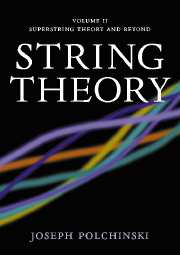Book contents
- Frontmatter
- Contents
- Foreword
- Preface
- Notation
- 10 Type I and type II superstrings
- 11 The heterotic string
- 12 Superstring interactions
- 13 D-branes
- 14 Strings at strong coupling
- 15 Advanced CFT
- 16 Orbifolds
- 17 Calabi–Yau compactification
- 18 Physics in four dimensions
- 19 Advanced topics
- Appendix B Spinors and SUSY in various dimensions
- References
- Glossary
- Index
16 - Orbifolds
Published online by Cambridge University Press: 26 February 2010
- Frontmatter
- Contents
- Foreword
- Preface
- Notation
- 10 Type I and type II superstrings
- 11 The heterotic string
- 12 Superstring interactions
- 13 D-branes
- 14 Strings at strong coupling
- 15 Advanced CFT
- 16 Orbifolds
- 17 Calabi–Yau compactification
- 18 Physics in four dimensions
- 19 Advanced topics
- Appendix B Spinors and SUSY in various dimensions
- References
- Glossary
- Index
Summary
In the final four chapters we would like to see how compactification of string theory connects with previous ideas for unifying the Standard Model. Our primary focus is the weakly coupled E8 × E8 heterotic string, whose compactification leads most directly to physics resembling the Standard Model. At various points we consider other string theories and the effects of strong coupling. In addition, compactified string theories have interesting nonperturbative dynamics, beyond that which we have seen in ten dimensions. In the final chapter we discuss some of the most interesting phenomena.
The two main issues are specific constructions of four-dimensional string theories and general results derived from world-sheet and spacetime symmetries. Our approach to the constructions will generally be to present only the simplest examples of each type, in order to illustrate the characteristic physics of compactified string theories. On the other hand, we have collected as many of the general results as possible.
String compactifications fall into two general categories. The first are based on free world-sheet CFTs, or on CFTs like the minimal models that are solvable though not free. For these one can generally determine the exact tree-level spectrum and interactions. The second category is compactification in the geometric sense, taking the string to propagate on a smooth spacetime manifold some of whose dimensions are compact. In general one is limited to an expansion in powers of α′/R2c, with Rc being the characteristic radius of compactification. This is in addition to the usual expansion in the string coupling g.
- Type
- Chapter
- Information
- String Theory , pp. 274 - 301Publisher: Cambridge University PressPrint publication year: 1998
- 1
- Cited by

